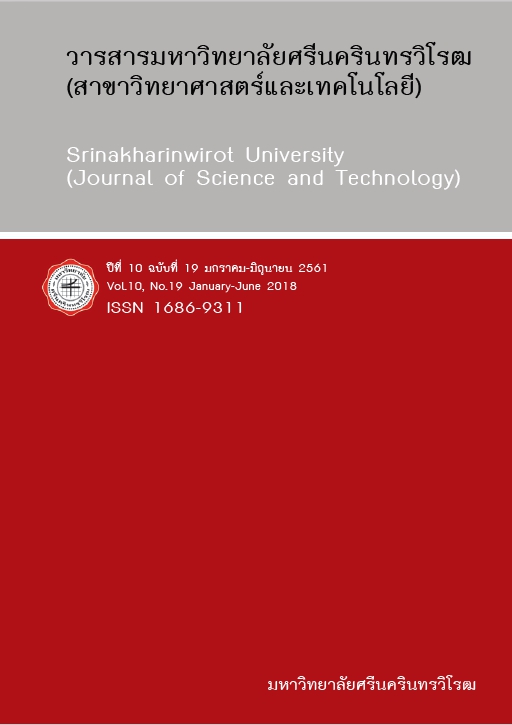การพยากรณ์การเปลี่ยนสีฟันหลังฟอกสีฟันด้วยระบบที่กระตุ้นด้วยแสงแอลอีดี โดยใช้แบบจำลองคอมพิวเตอร์ (PREDICTION OF COLOR CHANGE AFTER LED-ACTIVATED BLEACHING USING COMPUTER MODEL)
Keywords:
CIE Lab Color System, Bleaching, LED-Activated Bleaching System, Total Color Difference (ΔE), Bleaching Computer ModelAbstract
Abstract
The study aims to investigate the whitening efficacy of tooth change after bleaching, create and evaluate a bleaching predictive computer model to forecast the color change of teeth after LED whitening. A total of 30 subjects, age 18 to 32 years, were enrolled in the study by purposive sampling. 25% hydrogen peroxide activated with LED (ZoomTM, Discus dental Inc, USA) was used to bleach anterior teeth to the first premolar teeth. Shade evaluations on the right canine were performed before and immediately after treatment using Vita Classical Shade Guide and spectrophotometer (VITA Easyshade® advance, Vident, USA). Shade was determined by 2 dentists (Kappa = 0.704).
The Easyshade device indicated lightness (L*), red/ green (a*), yellow/ blue (b*) and color differences (∆E). A linear-regression equation was obtained from the color data to generate the Easy Click tooth color predictor computer model. The accuracy of the model was confirmed by 10 subjects.
The results showed that after treatment, the average total tooth color difference after treatment was 7.83±3.49 recorded by the VITA shade system. The mean shade change after active treatment was 8.07±.3.36. measuring by VitaEasyshade (Vident, USA). The equation in the linear regression analysis was ∆E = 0.309b*. The predicted ∆E equals 88.43 percent, while the mean square error was 33.6 percent. According to the bleaching computer model in 10 subjects, accuracy in color changing post bleaching was 90 percent.
Downloads
References
[2] Dahl JE, Pallesen U. (2003). Tooth bleaching-a critical review of the biological aspects. Crit Rev Oral Bio Med. 14(4): 292-304.
[3] Plotino G, Buono L, Grande NM, Pameijer CH, Somma F. (2008). Nonvital tooth bleaching: a review of the literature and clinical procedures. J Endod. 34(4): 394-407.
[4] Horn DJ, Bulan-Brady J, Hicks ML. (1998). Sphere spectrophotometer versus human evaluation of tooth shade. J Endod. 24(12): 786-790.
[5] ADA Council on scientific affairs. (2010). Tooth whitening/bleaching:treatment Considerations for dentists and their patients. Retrieved November, 2010, from: https://www.ada.org/sections/ about/pdfs/HOD_whitening_rpt_pdf
[6] Osborn J. Advantages of hierarchical linear modeling. PARE (serial online). (2000). Retrieved October 13, 2013, from: https://PAREomline.net/getvn.asp?v=7&n=1
[7] Imbery TA. Geissberger M, Hakim F, Al-Anezi S, Uram-Tuculescu S, Gottlieb R, Estrich CG. (2013). Evaluation of four dental clinical spectrophotometers relative to human shade observation ADA professional product review. JADA. 8(3): 1-12.
[8] Wattanapayungkul P, Matis BA, Cochran MA, Moore BK. (1999). A clinical study of the effect of pellicle on the degradation of 10% carbamide peroxide within the first hour. Quintessence Int. 30(11): 737-741.
[9] Zekonis R, Matis BA, Cochran MA, Al Shetri SE, Eckert GJ, Carlson TJ. (2003). Clinical evaluation of in-office andat-home bleaching treatments. Oper Dent. 28(2): 114-121.
[10] Marson FC, Sensi LG, Vieira LCC, Araujo. (2008). Clinical evaluation of in-office dental bleaching treatments with and without the use of light-activation sources. Oper Dent. 33(1): 15-22.
[11] Zhou X, Barker RD, Gerlach GRW. (2002). Impact of behavioral, clinical and demographic parameters on whitening response: evidence from 18 clinical trials. Research presented at the 80th General session of the IADR March 6-9.
[12] Lin CH, Chou TM, Chen JH, Chen JH, Chuang FH, Lee HE, Coluzzi DJ. (2008). Evaluation of the effect of laser tooth whitening. Int J Prosthodont. 21(5): 415-418.
[13] Kugel G, Papathanasiou A, Williams AJ 3rd, Anderson C, Ferreira S. (2006). Clinical evaluation of chemical and light-activated tooth whitening systems. Compend Contin Educ Dent. 27(1): 54-62.
[14] Franchi I, Franchi M, Bortolini S, Consolo U, Chau L. (2009). In vivo measurement of color changes in 1600 natural teeth with Pola office + (SDI, Australia): spectrophotometric shade analysis. Retrieved October 29, 2016, from: https://www.oralhealthgroup.com/features/in-vivo-measurement-of-colour-changes-in-1600-natural-teeth-with-pola-office-sdi-australia-spectro/
[15] Resis A, Dalanhol AP, Cunha TS, Kossatz S, Loguercio AD. (2011). Assessment of tooth sensitivity using a desensitizer before light-activated bleaching. Oper dent. 36(1): 12-17.
[16] Herrera LJ, Pulgar R, Santana J, Cardona JC, Guillén A, Rojas I, Pérez Mdel M. (2010). Prediction of color change after tooth bleaching using fuzzy logic for Vita classical shades identification. Applied Optics. 49(3): 422-429.
[17] Gerlach RW, Barker ML, Sagel PA. (2002). Objective and subjective whitening response of two self- directed bleaching systems. Am J Dent. 15: 7A-15A.
[18] Ishikawa-Nagai S, Terui T, Ishibashi K, Weber H, Ferguson M. (2004). Prediction of optical efficacy of vital tooth bleaching using regression analysis. Color research and application. 29(5): 390-394.
Downloads
Published
How to Cite
Issue
Section
License
Srinakharinwirot University Journal of Sciences and Technology is licensed Under a Creative Commons Attribution-NonCommercial-NoDerivs 4.0 International (CC-BY-NC-ND 4.0) License, Unless Otherwise Stated. Please Read Journal Policies Page for More Information on Open Access, Copyright and Permissions.



